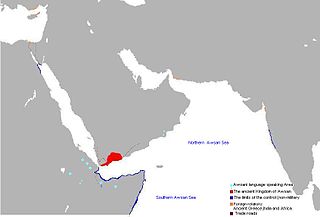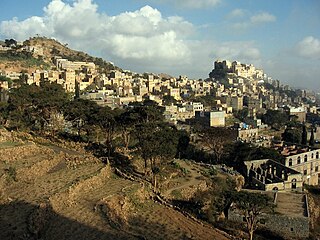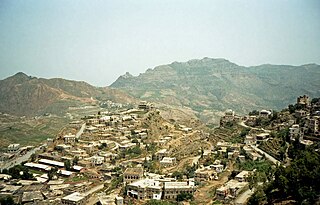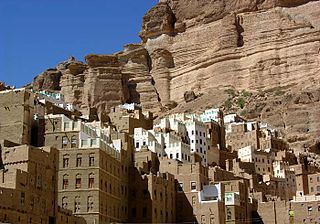
The Kingdom of Saudi Arabia is a country situated in West Asia, the largest country of Arabia, by the Arabian Peninsula, bordering the Persian Gulf and the Red Sea, north of Yemen. Its extensive coastlines on the Persian Gulf and Red Sea provide great leverage on shipping through the Persian Gulf and the Suez Canal. The kingdom occupies 80% of the Arabian Peninsula. Most of the country's boundaries with the United Arab Emirates (UAE), Oman, and the Republic of Yemen are undefined, so the exact size of the country remains unknown. The Saudi government estimate is at 2,217,949 square kilometres, while other reputable estimates vary between 2,149,690 and 2,240,000 sq. kilometres. Less than 7% of the total area is suitable for cultivation, and in the early 1960s, population distribution varied greatly among the towns of the eastern and western coastal areas, the densely populated interior oases, and the vast, almost empty deserts.

Hadhramaut is a region in South Arabia, comprising eastern Yemen, parts of western Oman and southern Saudi Arabia. The name is of ancient origin, and is retained in the name of the Yemeni Governorate of Hadhramaut. The people of Hadhramaut are called Hadarem. They formerly spoke Hadramautic, an old South Arabian language, but they now predominantly speak Hadhrami Arabic.

The ancient Kingdom of Awsān in South Arabia, modern-day Yemen, with a capital at Ḥajar Yaḥirr in Wādī Markhah, to the south of Wādī Bayḥān, is now marked by a tell or artificial mound, which is locally named Ḥajar Asfal. Once it was one of the most important small kingdoms of South Arabia. The city seems to have been destroyed in the 7th century BCE by the king and Mukarrib of Saba' Karab El Watar, according to a Sabaean text that reports the victory in terms that attest to its significance for the Sabaeans.

Zabid is a town with an urban population of around 52,590 people, located on Yemen's western coastal plain. It is one of the oldest towns in Yemen, and has been a UNESCO World Heritage Site since 1993. However, in 2000, the site was placed on the List of World Heritage in Danger.

Marib is a governorate of Yemen. It is located 173 kilometers to the northeast of Yemen's capital, Sana'a. The population of Marib Governorate comprises 1.2% of the country's total population. The city of Marib is the capital of the governorate, and was established after the discovery of oil deposits in 1984. The total number of residents living in the governorate was 238,522 according to the 2004 census, and the rate of growth was 2.72%.

Al Mahwit is the capital city of Al Mahwit Governorate, Yemen. It is located at an elevation of about 2000 metres.

Hajjah is the capital city of Hajjah Governorate in north-western Yemen. It is located 127 kilometres northwest of Sana'a, at an elevation of about 1800 metres. As of 2003, the Hajjah City District had a population of 53,887 inhabitants.

Taiz is a governorate of Yemen. The governorate's capital is Taiz, which is the third-largest city in Yemen. Today it is among the most important commercial centres in Yemen, owing to its proximity to rich farmland in the nation and to the important Red Sea port of Mocha. It also has an international airport, Taiz International Airport, with numerous services within Yemen and to neighbouring countries.

The Arabian leopard is a leopard subspecies native to the Arabian Peninsula. It has been listed as Critically Endangered on the IUCN Red List since 1996 as fewer than 200 wild individuals were estimated to be alive in 2006. The population is severely fragmented. Subpopulations are isolated and not larger than 50 mature individuals. The population is thought to decline continuously.
The Minaean language was an Old South Arabian or Ṣayhadic language spoken in Yemen in the times of the Old South Arabian civilisation. The main area of its use may be located in the al-Jawf region of North-East Yemen, primarily in the Wādī Madhāb. Most of texts in this language were composed by the Minaeans, but the other civil-temple communities of the Wādī Madhāb also used it as a literary medium.
Muqbil bin Hadi bin Muqbil bin Qa’idah al-Hamdani al-Wadi’i al-Khallali was an Islamic scholar and a major proponent of Quietist Salafism in Yemen. He was the founder of a Madrasa in Dammaj which was known as a centre for Salafi ideology and its multi-national student population. Muqbil was noted for his fierce criticisms of the Egyptian Islamist scholar Sayyid Qutb.

Wadi Dawan is a town and desert valley in central Yemen. Located in Hadhramaut Governorate, it is noted for its mud brick buildings.

The Southern Movement, sometimes known as the Southern Separatist Movement, or South Yemen Movement, or Aden Movement, and colloquially known as al-Hirak, is a political movement and paramilitary organization active in the south of Yemen since 2007, demanding secession from the Republic of Yemen and a return to the former independent state of South Yemen. At present, its best-known political offshoot, the Southern Transitional Council led by Aidarus al-Zoubaidi, is the de facto leadership across many provinces of the south.
Al-Shihr District is a district of the Hadhramaut Governorate, Yemen. The district had a population of 73,482 people as of 2012, and possibly 101,975 by 2015 numbers.

The wildlife of Saudi Arabia is substantial and varied. Saudi Arabia is a very large country forming the biggest part of the Arabian Peninsula. It has several geographic regions, each with a diversity of plants and animals adapted to their own particular habitats. The country has several extensive mountain ranges, deserts, highlands, steppes, hills, wadis, volcanic areas, lakes and over 1300 islands. The Saudi Arabian coastline has a combined length of 2,640 km (1,640 mi) and consists of the Gulf of Aqaba and the Red Sea to the west while a shorter eastern coastline can be found along the Persian Gulf.
The Wadi Turabah Nature Reserve is a protected area in the Makkah Region of southwestern Saudi Arabia. It is situated about 150 km (93 mi) south-east of Ta'if and 80 km (50 mi) north of al Bahah, sandwiched between the road between Taif and al Bahah and the road running along the escarpment between Banu Sa'ad and al Bahah. It adjoins the Jabal Ibrahim/Wadi Buwwah Protected Area, Jabal Ibrahim being a granite mountain rising about 1,000 m (3,300 ft) above the surrounding rocky hills. Wadi Turabah and Jabal Ibrahim have a total area of around 42,000 hectares and the elevation rises from 1,600 m (5,249 ft) to 2,604 m (8,543 ft) at the summit of Jabal Ibrahim.
Al-Abnāʾ was a term that was used in pre-Islamic and early Islamic Yemen to refer to the descendants of Iranian soldiers who had intermarried with local Arab women in southern Arabia after its conquest by the Sasanian Iranian Empire. Sasanian Iranian troops were garrisoned in Sanaʽa and its surrounding regions following the Sasanian Iranian reconquest of Yemen from the Aksumite Ethiopian Empire in the 570s CE. Their leaders largely converted to Islam following the rise of Muhammad and were active in the early Muslim conflicts.











